Charges that the Green New Deal will crash the budget and serve as an antechamber to socialism are just as bogus as similar arguments against its Depression-era predecessor, writes Steve Fraser.
By Steve Fraser
TomDispatch.com
 “We are in a new era to which I do not belong,” ex-President Calvin Coolidge confided to a close friend on a cold December day in 1932 when the country and the world were already in the depths of the Great Depression. A few weeks later, he punctuated that melancholic thought by dying.
“We are in a new era to which I do not belong,” ex-President Calvin Coolidge confided to a close friend on a cold December day in 1932 when the country and the world were already in the depths of the Great Depression. A few weeks later, he punctuated that melancholic thought by dying.
Coolidge was right. Within months of his death, President Franklin Delano Roosevelt, also known as FDR, would launch a “New Deal,” a wide-ranging set of programs to promote economic recovery that would recreate the American political universe. From that moment to this one, it has served as ground zero for the country’s political imagination, the Rosetta Stone for understanding every enduring political development of the last 75 years.
President Harry Truman’s “Fair Deal” (including proposals for universal health insurance and federal aid to education) and President Lyndon Johnson’s “Great Society” were conceived as elaborations and extensions of what the New Deal had wrought in the 1930s. “Neo-liberalism” and the “new conservatism” were invented to undo what their creators considered its damage.
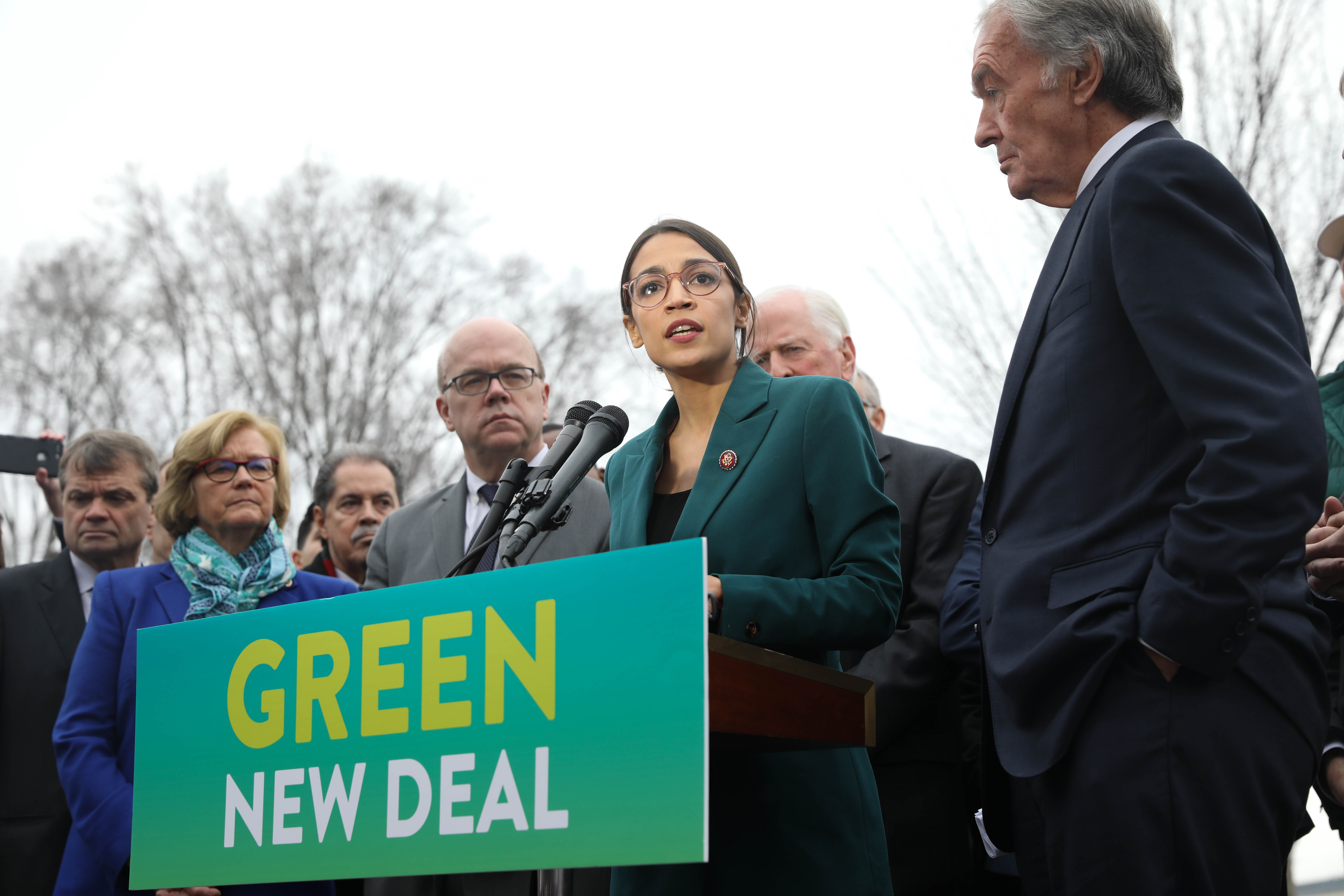
Rep. Alexandria Ocasio-Cortez (center) speaking on the Green New Deal with Sen. Ed Markey (right) in February 2019. (Senate Democrats, CC BY 2.0, Wikimedia Commons)
Today, the “Green New Deal” — a 10-year plan introduced by New York Congresswoman Alexandria Ocasio-Cortez and Massachusetts Sen. Ed Markey to transition to 100 percent renewable energy, while embarking on major social reforms — marks the far horizon of the left-liberal imagination. For those opposed to it, the Green New Deal, like the original one, is already considered little but camouflage for a program to introduce socialism to America.
Like its predecessor, it arrives on the scene at a fateful moment. There is no way to exaggerate the gravity of the Great Depression in its time or the looming prospect of climate catastrophe in ours. The question is: Could the Green New Deal do what the first one did to stave off the worst — or even do more? In this case, facing the reality of a fast-heating planet in a country whose president is Donald J. Trump, looking back is a way of looking forward.
Truth & Consequences
Republicans and conservatives of every stripe defamed Democratic President Roosevelt’s New Deal from its inception, as has been true of the very idea of a Green New Deal in the age of Trump. Vitriol was then and is now focused on two supposedly fatal flaws in those plans. The New Deal was quickly denounced as a form of fiscal suicide, of reckless venturing into deficit spending sure to bankrupt the economy and so the country. Its promise of recovery from economic disaster was decried as at best a chimera, at worst as cynical political chicanery meant to win votes in the here and now while leaving future generations to deal with the consequences. As if that weren’t bad enough, such an ambitious program focused on enlarging the government’s presence and power would surely open a highway to communism.
>>Please Donate to Consortium News’ Fall Fund Drive<<
More than eight decades later, the very same charges are surfacing again to undermine support for the Green New Deal. It is said to be a financial monstrosity that can’t conceivably work. One critic typically slammed it as “economically, technologically, and historically illiterate.” Another warned that it was not only “unrealistic,” but “the economic and social devastation it would cause is… serious and real.” And just in case it were to somehow work, it’s guaranteed to turn twenty-first-century America into a collectivist hell.
In his moment, Roosevelt was acutely sensitive to such accusations. At first, he adhered to the sacrosanct orthodoxy of balanced budgets. He even went so far as to delay the payment of bonuses promised to veterans of World War I, a decision that had already blackened the reputation of his predecessor, Herbert Hoover. (Hoover had also sent in troops to violently disperse a “bonus army” of protesting vets encamped outside the White House.)
Even when the New Deal reached its heyday, FDR would never feel completely comfortable with deliberately unbalancing the budget to spur the economy. Indeed, what was known as the “Roosevelt recession” of 1937-1938 — an economic nosedive in a moment of seeming recovery from the depths of the Great Depression — could be blamed, in part, on his decision to rein in government spending. For the next two generations, however, once-taboo deficit spending became the new liberal orthodoxy for a simple reason: despite the prophecies of opponents, it worked.
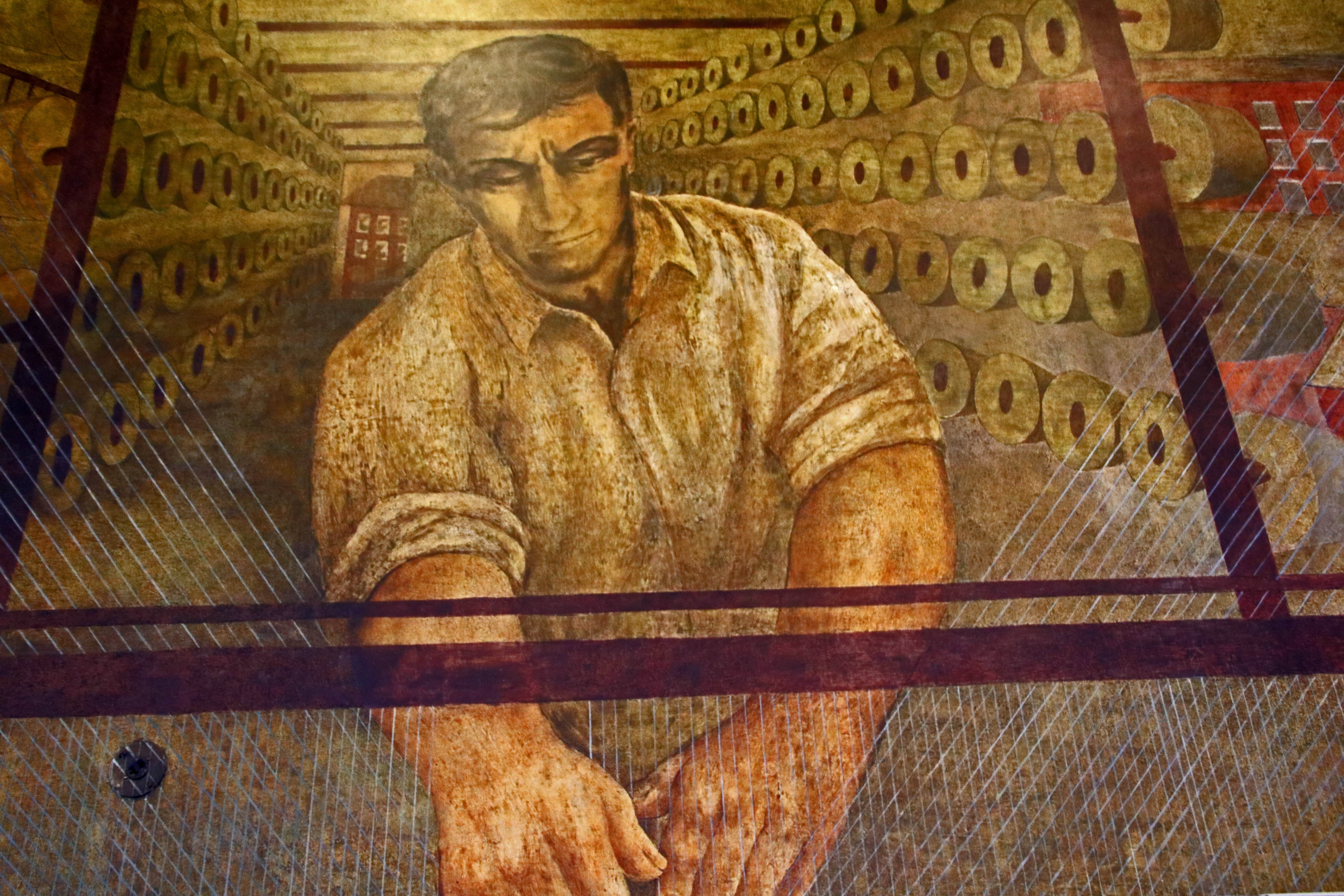
One of 13 murals in the Bronx General Post Office created by New Deal artists. (Wikipedia)
So, too, the president tried again and again to reassure the business world that the New Deal was designed to save capitalism, not overthrow it. During a ferocious debate over his administration’s “wealth tax act,” FDR tried to explain: “I am fighting communism… I want to save our system, the capitalistic system.”
Indeed, the New Deal would do just that. All the mechanisms it installed — deficit spending, redistributive tax laws, government regulation of industry, welfare and labor law reform, social security, a vast range of public works, including significant efforts at reforestation and conservation — helped rescue American capitalism from what had looked like a terminal crisis.
Just as bogus are today’s charges that the Green New Deal will crash the budget and serve as an antechamber to socialism. Calling it out as a financial disaster waiting to happen sounds especially hollow coming from a Republican Party that has already created a budget deficit surpassing a trillion dollars for the first 11 months of fiscal year 2019.
In addition, the idea of financing the transformation of the energy sector to alternative sources was bound to generate fierce opposition from the fossil fuel industry and its allies. No less disturbing to the equanimity of its opponents are ideas like creating specialized public banks, eliminating subsidies to that very industry, and passing new taxes on the wealthy and business to finance what will indeed be an expensive overhaul of the economy.
Yet the Green New Deal contains no frontal assault on private enterprise. For that matter, it doesn’t even threaten to completely abolish the fossil-fuel industry itself. A carbon tax — a levy on the carbon content of fuels — and “cap and trade” — placing a limit on carbon emissions while allowing firms that exceed it to buy the right to do so from those that stay under that ceiling — sometimes appear as part of its portfolio of solutions. Neither, however, represents a fundamental threat to capitalism’s reliance on the marketplace as the ultimate arbiter of what to produce and not to produce.
Nuclear power remains an option under the plan, as do future possibilities for carbon capture and storage; for, that is, the development of a technology for capturing carbon waste from the atmosphere and storing it, possibly underground, which would allow coal and gas production to continue. Nor does the Green New Deal flirt with nationalizing the energy sector. Like its predecessor, this New Deal remains focused on leveraging private investment with public funds. Its vision of creating public enterprises and joint public-private projects is neither more nor less radical than the public works undertaken by the original New Deal, which led to the creation of much of the country’s once massively successful, now deeply decaying infrastructure.
Indeed, the Green New Deal’s promise that millions of decent-paying jobs will result from its climate-change-oriented investments echoes the rationale and real accomplishments of the first New Deal’s recovery efforts, especially its various public works. Neither then nor now, however, were or are proponents inciting the working class to run the new industries to be created.
The original New Deal and the Green one are both responses to profound ruptures in the existing order of things. Both embrace reform of that existing order. Neither contemplates its extinction.
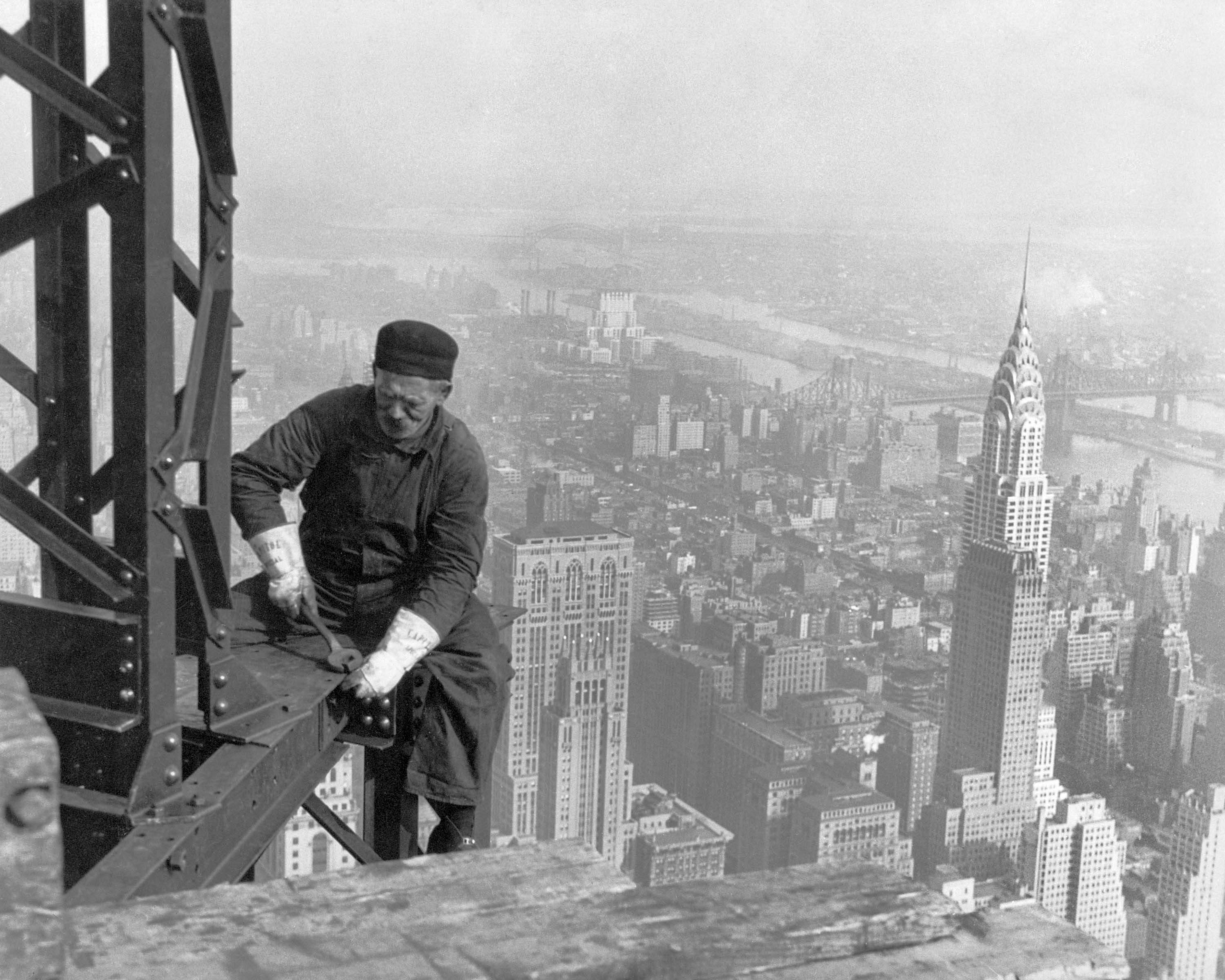
Lewis Hine photograph of Empire State Building worker in 1931. (Wikimedia Commons)
It’s important to add that the Green New Deal, despite the bow to the old one in its name, is anything but pure imitation. To begin with, the scale of its public investments would dwarf those of the original, which allotted an estimated 13 percent of the country’s gross domestic product to its public works spending. Green New Deal projects, as now imagined, would probably at least double that.
Furthermore, at least as a proposal, the Green New Deal is even more socially capacious than the old one, embracing as it does the need for universal health care, a guaranteed annual income, a program of affordable housing, commitments to truly clean water and air, and a revolution in the production of healthy food. In the way it forefronts the struggle for social, racial, and environmental justice, it also goes beyond anything the original New Dealers contemplated.
Perhaps its most potent political promise is to heal the deep wound that has opened up between abandoned parts of rural and urban America, the zones most damaged by the deindustrialization and financialization of the economy over the past half-century. People in both of those areas survive by working in prisons or in the vast warehouses of retailers like Walmart located in the American outback. They do temp work, are employed as piece workers in the online gig economy, or hustle in underground enterprises, while prey to toxic environments. They have much in common, but peer at each other as if across a vast abyss or from enemy encampments. The Green New Deal, like its political forebear, offers the hope of mutual recovery by explicitly siting some of its renewable energy projects in the ghost towns of once industrial cities and on the economically exhausted and depopulated landscapes of rural and small-town America.
All of this suggests that, very much like its predecessor, it conceives of itself within the framework of capitalism as we have known it, even while offering a menu of reforms daring enough to challenge some of its underlying premises. Both New Deals pose this question: In worlds of grotesque inequality, which shall prevail, wealth or commonwealth?
Capitalism may sometimes be restrained or civilized, but it is by nature predatory like a great white shark. In the 1930s, when mass mobilizations drove it to the left, the original New Deal pressed against the limits of the existing order. The Green New Deal may contain that same potential. At some point, assuming it becomes more tangible than a prospectus in a world in which Donald Trump and crew are no longer running things, its promoters will face choices about how to treat that order.
Yet, kindred as they may be in substance and intention, the circumstances that gave them life differ in fundamental ways that may bear heavily on what lies ahead.
Through a Glass Darkly
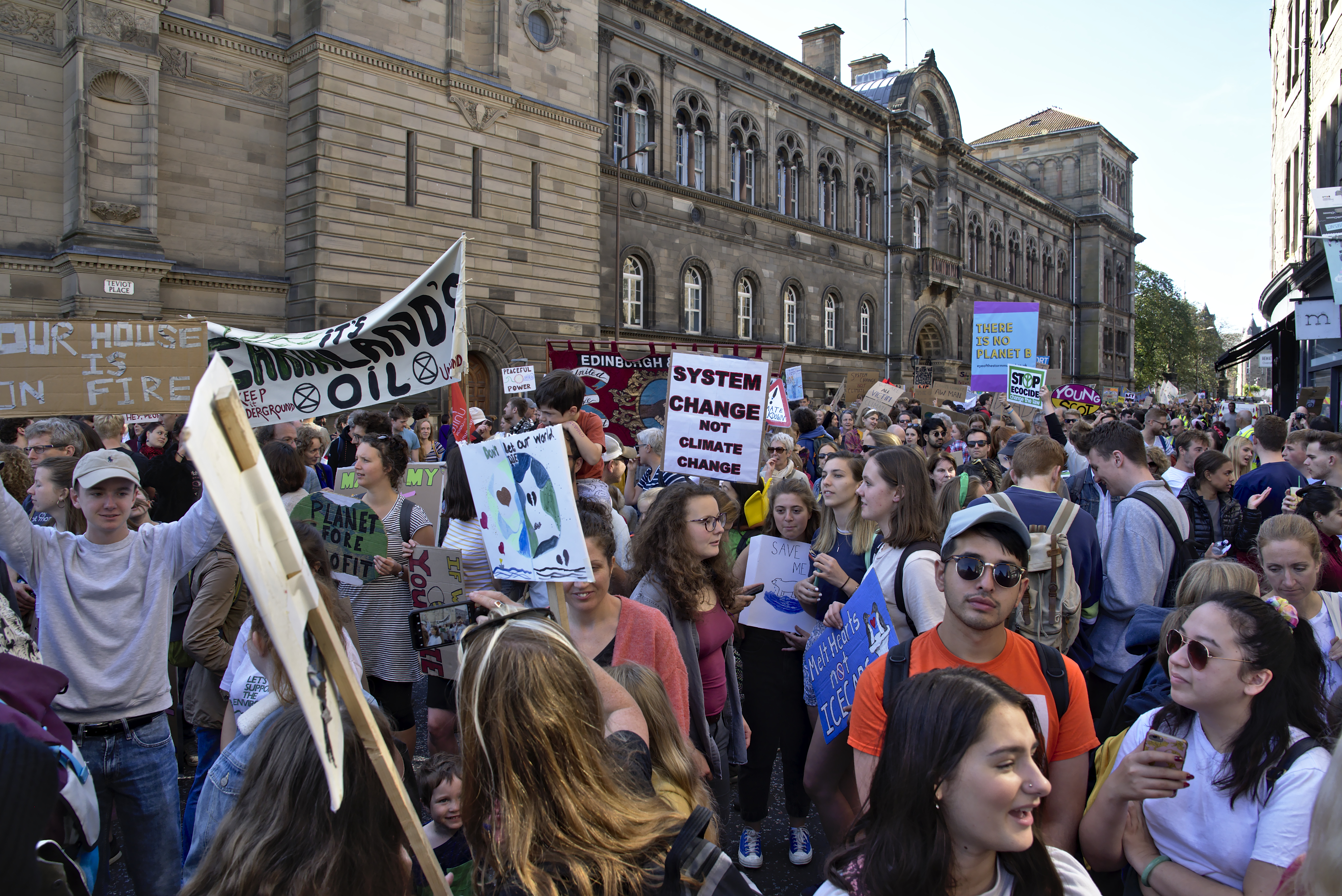
Global Climate Strike, Sept. 20, 2019, Edinburgh, Scotland. (Magnus Hagdorn, CC BY-SA 2.0, Wikimedia Commons)
Advocates of the Green New Deal talk ominously about the existential threat that global warming poses to civilization. And that threat visibly grows more real with each passing year. The Great Depression, however, was not a threat that was likely to happen soon — or sooner or later. For millions of people across the country it was the all-encompassing reality of the here and now. Think of the difference in the two moments as one between an existential threat and an existential crisis.
We are, of course, already witnessing or suffering from the early consequences of the climate crisis and that experience has produced enough anxious anticipation of worse to come to compel millions to protest. But because we are still largely gazing into disaster’s crystal ball (though one we can grimly count on for its scientific accuracy), global warming as a practical matter still remains one issue, however large, among a host of other pressing issues. In 1932, the Great Depression was essentially the only issue. Nobody was foolish enough to pretend it wasn’t happening. There were no Great Depression deniers. Clearly, the same cannot be said about the climate crisis.
Context is everything and in this case may account for the slower, if still irresistible, pace with which the struggle against planetary death has grown — compared, at least, to the rapid mass mobilizations on both the left and right that characterized the era of the Great Depression. The environmental movement, like the looming crisis itself, is incremental.
Something more troubling follows from that. Governments and private elites have largely managed to evade or put off serious action, offering palliatives of little real account or, in the case of Donald Trump and his administration, working feverishly to heat the planet further for their own profit. Unfortunately, unlike the calamity of the Great Depression, which everyone could see demanded an immediate response of some sort, our calamity is elusive. One day, it’s brutally apparent right where we live; on another, far off in the distant Arctic or Amazon. Global yet widely diffused, subject to variable estimated timetables of disaster, it lacks the singular impact of the Great Depression… or, at least, will lack it until perhaps it’s too late.
The mercurial nature of a climate in flux has allowed the fossil-fuel industry to carry on remarkably uninterrupted. It has provided the powers-that-be more generally with a long-term reprieve. Most painfully, for decades it impeded the emergence of a mass movement over an issue that seemed to many (thanks, in part, to the efforts of that same industry) to be based on a hypothesis. Those days are apparently drawing to a close. But it remains to be seen when climate change will assume the Great Depression-style status of the dilemma that must be solved before all others, the crisis that embraces all other crises.
The Ghost in the Machine
If context is critical, so is timing. The New Deal was made possible by mass movements of insurgent industrial workers, the unemployed, farmers facing foreclosure and ruin, urban dwellers facing eviction, and small businessmen facing extinction, among others. And what lent all of the organizing and political activism of that moment immense energy and focus was the previous half-century of anti-capitalist resistance that had punctuated American life from the Gilded Age of the late 19th century on.
Ironically, the New Deal saved capitalism by drawing on and transforming the very anti-capitalist sentiment that had pervaded American society since the days when William Jennings Bryan, the Democratic-Populist Party candidate for president in 1896, vowed that Wall Street would no longer be permitted to “crucify mankind on a cross of gold.” It was that heritage, not Roosevelt’s empathy for “the forgotten man,” that managed to domesticate a remorseless capitalism that had long functioned without a conscience.
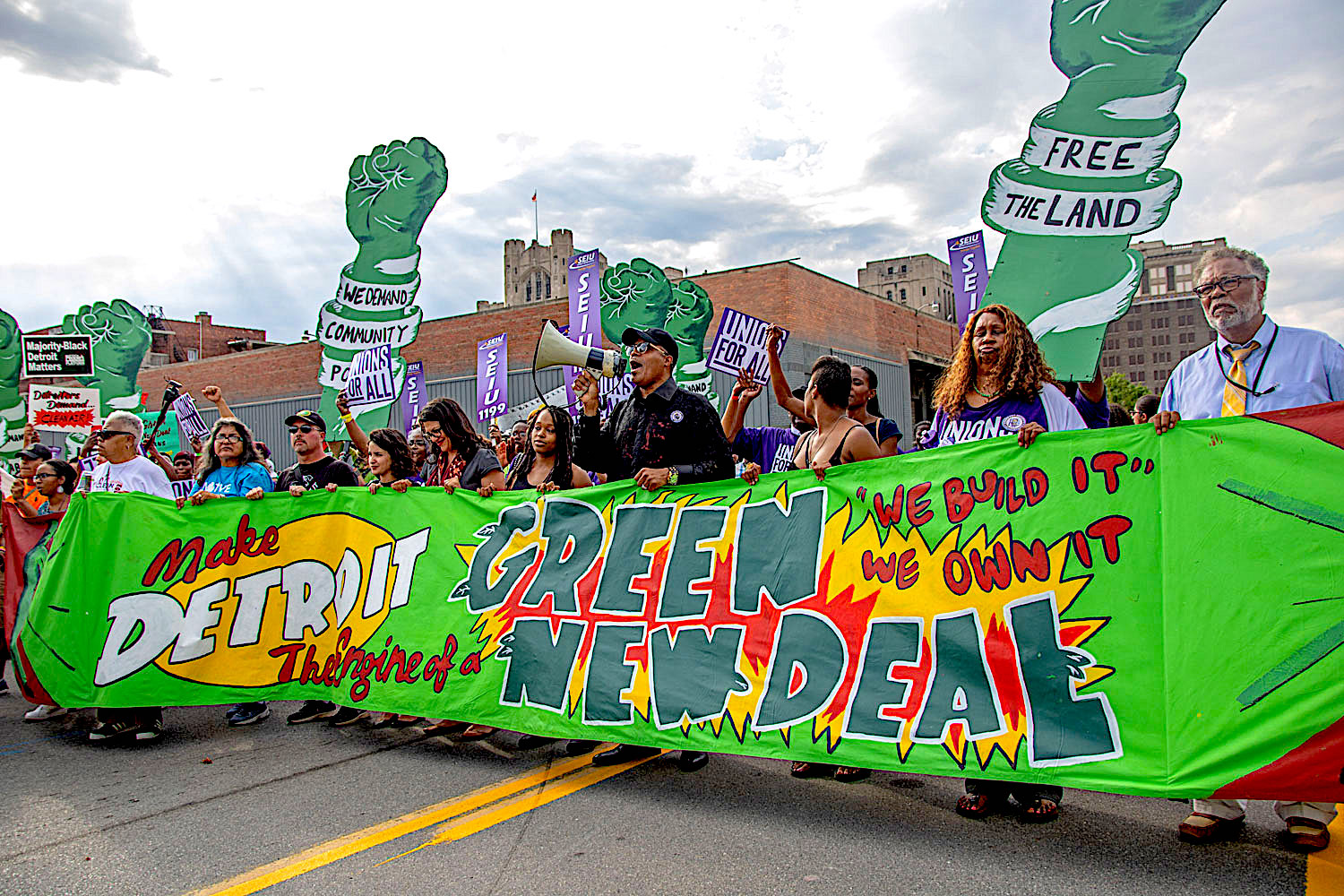
Green New Deal labor activists in Detroit, July 2019. (Becker1999, CC BY 2.0, Wikimedia Commons)
No similar heritage has been bequeathed to the Green New Deal. Beginning with the election of Ronald Reagan as president in 1980, a quiescent mood settled over the country that would last a long generation. During that protracted hiatus, the anti-capitalism that had once been part of the warp and woof of American culture either withered away or was banished, along with much of the organized labor movement.
Intermittently in the last decade, however, a fresh rebelliousness has emerged as popular movements began to contest the status quo, none of them more durable than the environmental movement. At the same time, a new anti-capitalism has begun to enliven our political language, thanks to the Great Recession, Occupy Wall Street protests, and the Bernie Sanders phenomenon.
Yet something vital is missing: an insurgent labor movement. To the degree that the New Deal was driven to the left and managed to seriously restrain capitalist appetites, millions of newly organized workers made that happen. The labor movement of that era was the central axis around which all other struggles for social and economic reform pivoted. For a time, it not only defended its own interests but championed the needs and desires of all those laid low, exploited, and oppressed. Everyone from presidents to poets, industrial tycoons to the invisibles manning the nation’s assembly lines, sweatshops, and factories-in-the-field had, for half a century, agreed that “the labor question” was the pre-eminent social question of the moment. The New Deal became, for better and worse, the answer.
Today, what’s left of the organized labor movement (a mere 6 percent of the private sector workforce) is but a pale remnant of that era. More sobering still is the mordant reality that, when it comes to global warming and what (if anything) to do about it, that already parlous labor movement is split. Many of the unions in the energy and allied industries are ready to defend their vested interests in the fossil-fuel economy. They perceive the Green New Deal as a job destroyer, not a job creator.
This need not be the case. Startling numbers of trade unionists from around the world participated in the Climate Strike of Sept. 20th, while the Green New Deal has the potential to win over a portion of the working-class that observers have too casually consigned to Trumpism.
Thanks to its promise of millions of new well-paid jobs, its concern with the health and environmental well-being of marginalized communities, and its commitment to labor’s right to organize and participate in erecting and directing the new economy, the Green New Deal offers a chance to win back people who voted first for Barack Obama and then for Donald Trump. At some point they will perhaps conclude that “yes we can” and the con-man theatrics of a billionaire populist were just two versions of fake news and search for a way out of the lockbox of the neoliberal order.
For this reason, the Green New Deal may come to embody a future more humane and liberating than what its ancestor imagined possible.
Steve Fraser, a TomDispatch regular, is the author of the just-published “Mongrel Firebugs and Men of Property: Capitalism and Class Conflict in American History.” His previous books include “Class Matters, The Age of Acquiescence, and The Limousine Liberal.” He is a co-founder and co-editor of the American Empire Project.
This article is from TomDispatch.com.
Before commenting please read Robert Parry’s Comment Policy. Allegations unsupported by facts, gross or misleading factual errors and ad hominem attacks, and abusive or rude language toward other commenters or our writers will be removed. If your comment does not immediately appear, please be patient as it is manually reviewed. For security reasons, please refrain from inserting links in your comments.
>>Please Donate to Consortium News’ Fall Fund Drive<<

Fraser is correct in pointing out that the absence of a strong Labor movement is the greatest threat to a meaningful Green New Deal. In the 1930s the US ruling class faced not only the new industrial unions of the CIO but also the threat of the example of the USSR, which grew at double digit rates throughout the depression, and a domestic Communist party with strong links to the new industrial unions. Together they formed a new pole of independent working class power both domestically and internationally.
The current conjuncture lacks such an independent counterpower. Instead we have a conflict between two factions of the ruling class. Having realized that denial and procrastination have run their course, and that the costs of climate change must be born by someone, a ruling class faction centered around the FIRE industries (Finance, Insurance & Real Estate) have decided to seize the initiative over the climate question. With their influence over the mainstream media and the Democratic party, it should be easy for them to strip the Green New Deal of any emancipatory potential and substitute a package of new ‘market signals’ and consumption taxes that will mostly fall on the working class.
The other faction of tbe US ruling class, centered on the fossil fuel companies and the Military-Industrial Complex, can count on substantial support from the working class and the downwardly-mobile middle class in opposing these regressive measures. Thus the social forces who could underpin a truely transformational Green New Deal if they could constitute an independent political project are set against each other on opposing sides of an ruling class dispute.
The Democrat’s GND is doomed to failure because it leaves out cutting the US military budget by a minimum of 50%. The US military is the biggest user of fossil fuels on the planet as well as the biggest emitter of CO2. The Green Party’s Green New Deal which was introduced by Howie Hawkins a decade ago does exactly that. He is now calling for a reduction of the military budget of 75%.
We don’t have time for hollowed out plans that don’t go far enough.
Agree that the Dem GND will fail for a number of reasons, not least of which is their complicity with the MIC.
However Mr. Hawkins reduction in military spending is only part of the answer. It seems so far that he’s still into the renewable replacement and economic growth paradigm (we’re not living in Debs’ early 20th Century world). That’s the killer. I would recommend the article in Counterpunch posted 9/17/19 by Don Fitz “What is Energy Denial?” Also another person I’ve found enormously insightful is Charles Eisenstein in his book, “Climate: A New Story”. As long as we remain in our current state of separation, the ecological destruction will continue unabated. Talk of war on climate change or New “Deals” will either do nothing or worse.
There are no saviours (sorry Greta).
I am reminded that Mao Tse-Dung after winning the revolution allowed many of the Chinese national capitalists to remain and continue to work while expelling and destroying the international capitalists.
So, from the beginning of communist China, there was a capitalist element. On the other hand, the State retained ownership of all property, which it does to this day, offering long-term leases. This is in contrast to Western values that place property ownership as the pinnacle of success and fulfillment, and that also consign so many to precarity, and ultimately, are the gravest impediment to the Green New Deal.
Meh, it’s all about saving American Capitalism.
The largest Military Complex on Earth consumes more Energy than any other entity on Earth! The Defense Dept.’s Energy Budget is $20 Billion!
One goal is to rely on 25% “renewable resources” by 2035 (15 years)
However, in the meantime, they’re consuming (confiscating) as much oil and energy as fast as they can, as their corporate beneficiaries crank out as many trucks and SUV’s as fast as they can..all the while, producing hybrids & electric vehicles.
First there really is no comparison between the cause of the New Deal and this tsunami in process. So be careful on this and the other used motif of WWII mobilization. These compound the problem by totally mis-identifying it.
Second this sounds much more like eco-modernism. That is green-capitalism, aka green-washing.
I think this response will fall apart as conditions worsen. Swapping out energy sources will not improve matters. We need to rethink, as hard as it is for some (which is why Trump has been so successful in shutting down efforts against extraction), how we live on the planet, not find other ways to continue doing what we’ve been doing. Science can be helpful, but it also gave us the MIC wars and thermonuclear weapons.
It’s time to rethink this civilization, the economics of growth which has been the foundation of ecocide. Electric cars and wind/solar are just ecological destructive trade-offs, including the “jobs” these create. Challenging problem. You bet. The New Deal put a pause on things to continue capitalisms predatory ways. So such comparisons are really dead-ends in the final analysis.
“We can’t afford it” cries the media and government of the oligarchs, for the oligarchs, and by the oligarchs.
It’s time for the pitchforks.
This garbage is being pushed by the oligarchs, for the oligarchs. It is their creation.
We need a Mississippi River of fundamental change in our economy and politics, but what worries me is that The New Deal did not end the Depression or heal the economy, that came about because of WW2, the economies of the entire world outside of the U.S. were destroyed leaving us to pick up the pieces and put it back together. There is not, nor has there ever been, a society/culture/government that could achieve the degree of change implicit in the Green New Deal in a short time w/o first being destroyed.